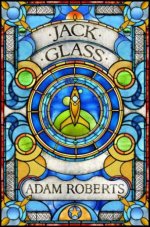
| Jack Glass | ||||||||
| Adam Roberts | ||||||||
| Gollancz, 373 pages | ||||||||
|
A review by David Soyka
While ostensibly a novel, it reads more like three connected novellas, with their own distinct mysteries and tone of voice
that are linked to, (or "docwatsoned," to use the enigmatic narrator's great invented term) "the greatest mystery of our
time…FTL." Roberts is, of course, poking fun at the Golden Age SF staple of faster than light travel, which despite being
theoretically impossible is nonetheless fictionally imperative to most any space opera. Some of the smaller puzzle pieces
are easy to guess, some you can't possibly anticipate. If Golden Age detective fiction provided hints, however misleading,
about a solution, Roberts has little use for such tradition. It does, however, make for a more shocking "reveal."
Such is the situation with the opening tale, "In the Box." Convict Jac (no mystery as to who he might be), is sentenced to an
eleven year sentence to the interior of a frozen asteroid. The expectation is that he and his fellow inmates will either manage
to survive, in which case the corporate prison overlords has a terraformed property to market, or they won't, in which case no
one will miss them and there's no investment loss. Despite their psychopathic tendencies, the jailbirds make successful
progress towards self-preservation. However, the legless (not an impediment in a near weightless environment, but the reason
for this won't be clear until much later) Jac needs to escape. Not just because he is low man on a brutal totem pole, but
because he fears his captors might discover who he really is and come back for him (who he really is being one of the
multiple mysteries). This requires some out-of-the-box thinking that is particularly gruesome, with anti-hero self-justification
that is more Dexter than Dashiell.
Suddenly we shift from the harsh Darwinism of the prison yard to an adolescent adventure yarn in the next, and longest
story, "The FTL Murder," which substitutes a precocious and spoiled Nancy Drew whodunit for sodomy and sadism among
criminals. "A month before she turned sixteen, Diana got involved in a real life murder mystery. It was... was...
was too exciting." Talk about a shift in perspective!
Vacationing with her ruling aristocratic family and tutor Iago (ominous symbolism there) on Earth (where it is so inconvenient to
have to get used to living with gravity again, particularly for the less than disciplined Diana), the mystery here is how a
household servant could have been killed, and, moreover, why anyone would want to kill him (don't even try to guess), though
the legendary Jack Glass serves as a kind of round up the usual suspect bogeyman. There's also a bit of sibling rivalry going
on between Diana and her more accomplished sister, Eva. And some kind of power play among Diana's family and other ruling
families, the reason for which leads to a possible solution to Fermi's paradox and flight by Diana and Iago.
All is explained in the concluding story, "The Impossible Gun," including the true identity of Jack Glass (remember, this is
supposed to be about a character who seemingly disappears less than a third of the way through, though you've probably already
guessed long before the denouement that he's in clear sight all along), his motivations for murder and why basically he isn't
such a bad guy after all.
This is all very clever and in keeping with Golden Age conventions (such as trying to sound smart by throwing in classic
literary references such as the aforementioned wink to Shakespeare which, if you really think about it, doesn't quite work)
that is simultaneously its major flaw. If you have affection for a period in SF literature characterized by scientific-sounding
preposterous notions mixed with social criticism in which one dimensional characters resolve plot points through various
deus ex machinas, then you'll smile throughout out this. If you don't, then you may not get the joke, or care to.
David Soyka is a former journalist and college teacher who writes the occasional short story and freelance article. He makes a living writing corporate marketing communications, which is a kind of fiction without the art. |
|||||||
|
|
If you find any errors, typos or anything else worth mentioning,
please send it to editor@sfsite.com.
Copyright © 1996-2014 SF Site All Rights Reserved Worldwide
